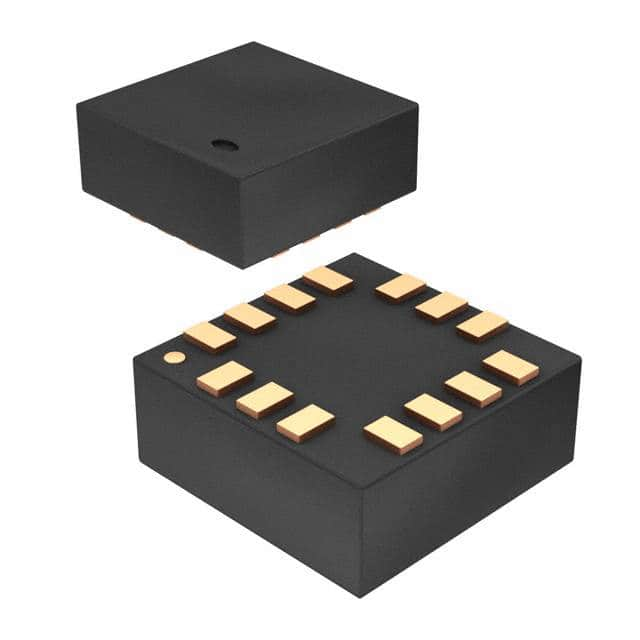LIS2DHTR
Product Overview
The LIS2DHTR belongs to the category of accelerometers and is commonly used for measuring acceleration in various electronic devices. This sensor is known for its compact size, low power consumption, and high accuracy, making it suitable for a wide range of applications. The package includes the essential components required for installation and operation, and the sensor is available in different packaging options and quantities to cater to diverse user requirements.
Specifications
- Dimensions: 3x3x1mm
- Sensitivity: ±2g/±4g/±8g/±16g
- Output Data Rate: 1Hz to 5.3kHz
- Supply Voltage: 1.71V to 3.6V
- Operating Temperature Range: -40°C to +85°C
Detailed Pin Configuration
The LIS2DHTR features a standard pin configuration with multiple pins for power supply, data output, and communication interface. The detailed pinout includes VDD, GND, SDA, SCL, INT1, and INT2, providing seamless integration with microcontrollers and other electronic components.
Functional Features
- High Accuracy: Provides precise measurement of acceleration.
- Low Power Consumption: Ensures minimal energy usage during operation.
- Digital Interface: Supports I2C and SPI communication protocols for easy integration.
- Embedded FIFO: Enables efficient data collection and storage.
Advantages and Disadvantages
Advantages
- Compact Size: Allows for integration into small form factor devices.
- Wide Operating Voltage Range: Compatible with various power supply configurations.
- High Sensitivity: Capable of detecting subtle changes in acceleration.
Disadvantages
- Limited Shock Resistance: May not be suitable for high-impact environments.
- Complex Initialization: Requires careful configuration for optimal performance.
Working Principles
The LIS2DHTR operates based on the principle of capacitive sensing, where changes in acceleration cause displacement of microstructures within the sensor, resulting in a measurable capacitance change. This change is then converted into digital signals for further processing and analysis.
Detailed Application Field Plans
The LIS2DHTR finds extensive application in the following fields: 1. Consumer Electronics: Used in smartphones, tablets, and gaming devices for motion detection and gesture recognition. 2. Automotive: Integrated into vehicle navigation systems and advanced driver assistance systems (ADAS) for impact detection and vehicle stability control. 3. Industrial Automation: Employed in robotics and machinery to monitor vibration and tilt for predictive maintenance and safety enhancement.
Detailed and Complete Alternative Models
- LIS3DH: Offers similar functionality with enhanced shock resistance.
- ADXL345: Provides competitive performance with a different form factor and interface options.
- MPU6050: Combines accelerometer and gyroscope functionalities for comprehensive motion sensing.
In conclusion, the LIS2DHTR accelerometer offers a compact and reliable solution for measuring acceleration in various electronic devices, catering to diverse application needs with its high accuracy and low power consumption. While it has certain limitations, its functional features and wide-ranging applications make it a valuable component in the realm of motion sensing technology.
Word Count: 443
Lista 10 Vanliga frågor och svar relaterade till tillämpningen av LIS2DHTR i tekniska lösningar
What is LIS2DHTR?
- LIS2DHTR is a high-performance three-axis linear accelerometer and temperature sensor.
What are the key features of LIS2DHTR?
- The key features include ultra-low power consumption, high resolution, digital output, embedded temperature sensor, and high shock survivability.
How can LIS2DHTR be used in technical solutions?
- LIS2DHTR can be used for motion-activated functions, tilt detection, pedometers, gaming and virtual reality input devices, and temperature monitoring.
What is the operating voltage range of LIS2DHTR?
- The operating voltage range is from 1.71V to 3.6V.
What is the output data rate of LIS2DHTR?
- The output data rate ranges from 1 Hz to 5.3 kHz.
Can LIS2DHTR be used in battery-powered applications?
- Yes, LIS2DHTR's ultra-low power consumption makes it suitable for battery-powered applications.
Is LIS2DHTR compatible with common microcontrollers?
- Yes, LIS2DHTR is compatible with common microcontrollers through its I2C and SPI interfaces.
What is the temperature range that LIS2DHTR can operate in?
- LIS2DHTR can operate in a temperature range from -40°C to +85°C.
Does LIS2DHTR support motion wake-up and free-fall detection?
- Yes, LIS2DHTR supports motion wake-up and free-fall detection, making it suitable for various applications.
Are there any application notes or reference designs available for LIS2DHTR?
- Yes, application notes and reference designs are available to assist in integrating LIS2DHTR into technical solutions.


